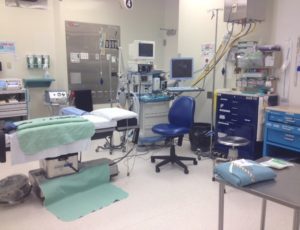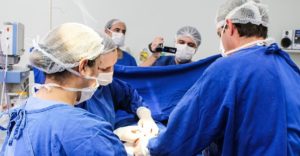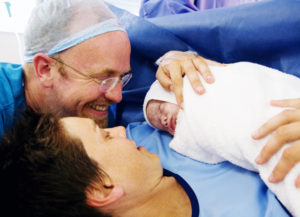A caesarean birth or c-section is the birth of the baby through an incision (cut) made into the abdomen and uterus. Caesarean births can be are planned or unplanned (done after labour has begun).
Reasons for Caesarean birth
A caesarean birth may planned for several reasons:
- Active herpes: The baby can become infected as they pass through the vagina so will need to be born by caesarean birth
- Placenta previa: Placenta previa is when the placenta is below the baby and lies over part or all of the cervix
- Breech position: This is when the baby is lying buttocks (bottom) or feet first. Some people with a baby in a breech position may be able to birth vaginally but will need to have a consultation to see if they are a suitable candidate
- Malpresentation: If the baby is lying in the transverse (sideways) position a caesarean birth is necessary as a vaginal birth is not possible
- Complicated multiple births (twins or triplets): Where one or more of the babies are breech or lying sideways (transverse position)
- Serious medical conditions: If the parent or baby have a serious condition that would make labour a risk
An unplanned caesarean birth could occur for several reasons:
- Labour is not progressing: If induction or augmentation is not working and labour is becoming tiring or stressful for the labouring person and/or baby
- Fetal distress: This occurs when the baby is not tolerating the stress of labour, medications or interventions being used in labour. Signs of fetal distress may be noted in a change in the baby’s heart rate and/or if there is meconium in the amniotic fluid
- Cephalopelvic disproportion (CPD): This means that the baby is too large to pass safely through the pelvis or the position of the baby’s head causes the labour not to progress as expected
- Vaginal bleeding: This may mean a problem with the placenta. Vaginal bleeding may occur if the placenta begins to separate from the wall of the uterus before the birth (abruptio placenta)
- Cord prolapse: Rarely, if membranes rupture in a gush, the cord can be carried along and become caught between the baby and the pelvis. If this occurs, every contraction compresses the cord and decreases the blood supply to the baby
Side effects of a Caesarean birth may include:
- Higher risk of hemorrhaging (increased blood loss)
- Unexpected incisions to baby or parent’s organs (e.g. the bladder)
- Higher risk of complications from anesthesia
- Higher risk of serious medical complications for the parent (e.g. blood clots)
- Longer hospital stay
- Increased pain following the surgery
- Longer recovery (e.g. reduced mobility because of pain and the impact on the abdominal muscles)
- Needing extra breast/chestfeeding support
- Long term risks for bladder issues and future pregnancies
Decreasing your chances of a Caesarean
Caesarean birth may be necessary for some people, but there are a number of things that you can do to decrease your risk of needing a caesarean delivery.
- Educate yourself on maintaining your health during pregnancy and about normal labour and birth
- Hire a Doula. Research has shown that people who have a trained doula supporting them in childbirth use less medication, have fewer interventions and have a lower caesarean rate
- Communicate with your caregivers
- Stay home in early labour
- Avoid unnecessary interventions. For instance, scheduling an induction because you are tired of being pregnant will increase the likelihood of needing a caesarean section
- Avoid using pain medication especially in early labour. Try using coping techniques that do not require medication for as long as possible
- Stay upright and moving during labour
Planned Caesarean
With a planned caesarean, the doctor will book the surgery with the hospital. On the day of the surgery, usually in the morning, the birthing person arrives at the hospital with their partner/support person .
It is recommended to have a late night snack the evening before the surgery. The birthing person will likely be instructed to not eat or drink anything for at least 8 hours before surgery, unless told otherwise by the anesthetist. It is recommended the birthing person takes a shower in the morning before coming to the hospital for their planned caesarean.
The nurses will :
-
Make sure that blood tests are done
-
Measure blood pressure, pulse, temperature, and also record the fetal heart rate
-
Insert a catheter (thin, rubber tube) into the bladder to make sure that the bladder is always empty
-
Start an intravenous (IV) line
-
Put support stockings on the lower legs to prevent blood pooling and clot formation
What to expect with a planned or unplanned Cesarean birth

It may seem like there are a lot of people in the operating room during a caesarean birth. Each person is there to do a certain job to ensure that the procedure goes well. There will be a group of professionals to care for the parent and another group to care for the baby once it’s born.
- The Anesthesiologist: Administers regional or general anesthesia and monitors its effectiveness, also monitors the vital signs of the parent and the baby during surgery
- The Doctors: An obstetrician will be in charge of performing the surgery, with another doctor assisting. It is possible that a third doctor or resident doctor may also assist
- The Nurses: There will be 2 or 3 nurses to assist the doctors and care for the parent
- The Baby Team: Can be made up of a combination of the following professionals depending on the circumstances of the baby’s birth:
- A nurse from the special care nursery (SCN) or Neonatal Intensive Care Unit (NICU)
- A paediatric resident and/or Neonatologist from NICU
- A respiratory therapist to assist the baby if he/she needs it
- The Support Person: It is encouraged for the support person/partner to be in the operating room. The support person can help the birthing parent relax and talk to them during the birth if they don’t have general anesthetic.
- In most cases one support person can be in the OR.
- The support person will have to change in to clean scrubs, put on shoe and hair covers, and wear a mask covering their nose and mouth.
- They are usually situated at the birthing person’s head and are given a stool to sit on.
- If it is an emergency caesarean birth there may be no time to get the support person ready.

During the surgery:
- The birthing parent will lie down on the operating room table which will tilt a bit to the left (there are supports on the side to keep them from slipping)
- Monitoring equipment will be used to check blood pressure and heart rate
- The abdomen and thighs will be washed and covered with sterilized cloths, leaving only a small area on the abdomen exposed. The arm with the IV, or possibly both arms, will rest on an arm board away from the body with straps to help hold them in place
- Before the surgery begins the birthing parent will receive anesthesia. Anesthesia has risks and benefits that can be discussed with the doctor and anesthesiologist. There are two different options of anesthesia that may be used:
- Regional anesthesia (epidural or spinal): This involves “freezing” the abdomen. The medication is given through a needle inserted into a space surrounding the spine. If regional anesthetic is used, the birthing parent will be awake and alert during the birth. After the birth, if the baby is healthy, they will be given to the parent(s) or support person to cuddle. Near the end of the surgery the anesthesiologist may inject additional pain medication into the epidural space for pain relief after the surgery.
- General anesthesia: The birthing parent will be asleep during the birth of the baby. When they are awake after surgery, they will then be able to see and hold their baby. General anesthesia is not used very often. It could be used if there isn’t time to administer regional anesthesia (in an emergency) or if the birthing person is unable to receive regional anesthesia because of a medical condition.
- They will check that the birthing parent is completely anesthetized before the surgery begins
- There are 2 types of incisions that the doctor may make on the abdomen and uterus
- The most common is a low transverse and lower segment incision. This incision heals with little scarring and is in an area that is better able to withstand the stress of a future vaginal birth. The surgeon will make an incision on the skin, low on the abdomen, along the “bikini” line, then into the lower segment of the uterus.
- Less commonly used is the vertical or “classical” incision. A doctor may choose to do a ‘classical’ incision if it is a critical emergency, if the baby is very premature and the lower segment of the uterus is not developed, or the baby or placenta is in a position such that a lower segment incision is not safe. The “classical” incision is through the main part of the uterus (downwards vertically from the belly button) and may be less likely to withstand the stress of a future vaginal birth.
- During the birth of the baby the birthing parent will feel pulling, tugging and pressure (but not pain) as the doctors help the baby to get in a position and then during the birth through the incision.
- Sometimes forceps or vacuum may be used to assist with the birth.
- Once the baby is born they are passed to the neonatal team to be assessed
- After the assessment, if the baby is healthy, they will be given to the parent(s) or support person to cuddle.
- The placenta is delivered through the incision.
- It then takes 30-45 minutes for the incisions to be repaired before the family is moved into a recovery room.

